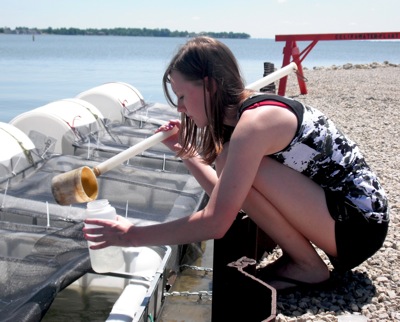Testing to grow profitable lake algae
GRAND LAKE - Some professors and a local student at Bowling Green State University are experimenting with Grand Lake water to get a less harmful type of algae to grow so it can be harvested.
The experiment, a collaboration between BGSU, the city of Celina and Algaeventure Systems, Marysville, began about four weeks ago.
In March, Celina officials met with professors who are researching Lake Erie algae issues. Similar to Grand Lake, Lake Erie has blue-green algae that produces a potentially harmful toxin.
"They wondered if there was a way to influence the water so a strain of algae that doesn't make the toxin could be grown," Celina Planning and Community Development Director Kent Bryan said. "Naturally we were interested."
Bryan has been looking into the possibility of harvesting the lake's algae for biofuel production for a couple years, but the strain in Grand Lake won't work because it is low in lipids (oil).
Algae higher in lipids is better for producing products such as biofuels, bioplastics and animal feed, said Chad Hummell of Algaeventure Systems.
"We thought if we could manipulate the nutrient contents we could change the composition of the algal community to something less harmful," said George Bullerjahn, one of the biology professors working on the project. "We are proposing that if we increase the amount of silica in the water, we can get a friendlier algae called diatoms to grow and be less toxic."
Diatom algae is a good source of oil, which makes it a good source for biofuel and bioplastic production, he said.
Passers-by driving onto West Bank Road may have noticed one of the experiment sites marked as Grand Lake Ecosystem Experiment (GLEE).
Six tanks filled with lake water are tethered along Grand Lake near Big Bamboo's Dockside Grill. The containers have open tops covered with mesh to let air in and keep debris out.
Two of the tanks (control) contain untreated lake water, two contain lake water seeded with nitrates and two contain lake water seeded with silica and nitrates. Nitrates are found in runoff into the lake while silica is not, Bullerjahn said. Silica is a natural element found in rocks and quartz. Glass is made of silica, Bullerjahn said.
There also are six tanks containing the same amounts of lake water, nitrates and silica at the water treatment plant.
Samples are being taken from all 12 tanks twice a week and lab work is being conducted at the Celina Water Treatment Plant, BGSU and Heidelberg College. The tests are designed to show what types of algae is in the water and if the populations change based upon what is added.
Bullerjahn said the lake experiment site is a more natural setting because the containers are in the water with open tops. The advantage of having a duplicate set of tanks at the plant is they are not exposed and can be monitored and controlled more closely, he said. The containers at the plant also will show how sunlight may be a factor in algae growth, he said.
Bullerjahn said the team plans to run two identical, six-week experiments. The second should wrap up in late July or early August.
If the experiment shows a "friendlier" algae could be stimulated to grow, Algaeventure Systems might consider sectioning off small portions of the lake to harvest it, Bullerjahn said. It is still unknown what effect this might have on the blue-green algae.
Taking the water samples each week is Katrina Thomas, a junior at BGSU and a lifelong resident of St. Marys. Assisting her is Ben Beall, a post-doctorate fellow at BGSU who works with Bullerjahn, and professor Mike McKay.
Thomas said she has been aware of the lake's excess nutrient and algae issues for some time.
"I like to know what is going on and why," she said. "Since I live here, I'm glad I have a hand in helping it."
Local officials have known of Grand Lake's blue-green algae problem, but it was more of a nuisance. It colors the water green, causes slimy slicks on the surface and sometimes kills fish. The problem became an economic nightmare for the area last summer when the state issued a water quality advisory because of a toxin produced by the algae.
The advisory was lifted in April after toxin levels dropped, but a huge algae bloom Monday put the issue back in the spotlight. Excess nutrients that run off farmland is what feeds the blue-green algae.
Harvesting test set this summer:
Algaeventure Systems, Marysville, plans to test algae harvesting equipment in the lake this month.
The test will help determine the feasibility of removing algae from natural bodies of water to use as an energy source, said company spokesman Chad Hummell. The test also will help determine the feasibility of removing nutrients (phosphorous and nitrates) as a way to improve the lake's water quality, he said.
The company's specialty is making algae harvesting equipment. The company grows algae in 11-by-200-foot covered ponds at its Marysville facility, but it has done little work harvesting from natural water bodies, Hummell said.
"Green energies have been gaining popularity especially due to what's happening in the Gulf, but with Grand Lake we have to find a way to help remediate the lake, no matter what the source of the N and P is," Hummell said. "Drawing the algae out is a way to help do that."
Hummell said the lake's blue-green algae isn't conducive for biofuel or bioplastic production but it might be used as a biomass that can be burned to create electricity.
Hummell said removing algae and nutrients isn't the only answer, but just one piece of a larger plan to address the lake's water quality concerns.
"It not the silver bullet, but a thing that can work with all the other stuff going on and add up," he said.
- Nancy Allen


